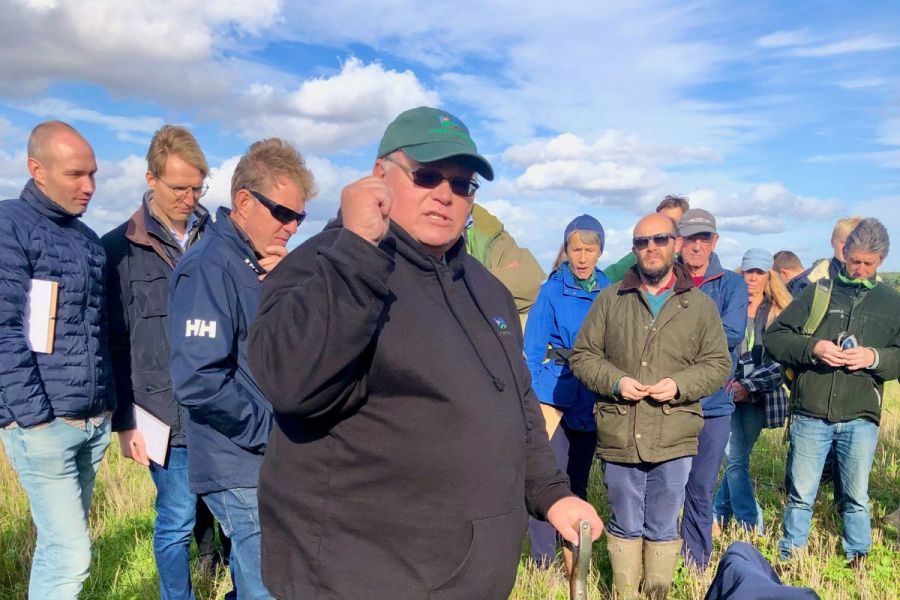Regenerative agriculture royalty Gabe Brown and colleagues spoke to 250 farmers and advisers at a special Groundswell workshop in October, hosted by the Cherry family. CPM was there.
“Regenerative agriculture is a thinking person’s game.”
By Mike Abram
The first thing US regenerative pioneers Gabe Brown, Dr Allen Williams and Shane New do when they start talking to the 250-strong sell out audience at John and Paul Cherry’s farm in Hertfordshire – site of the Groundswell event – is to take a picture.
Gabe jokes his wife once said she wouldn’t cross the road to hear him talk, so he wants evidence that UK farmers are happy to travel to hear him speak.
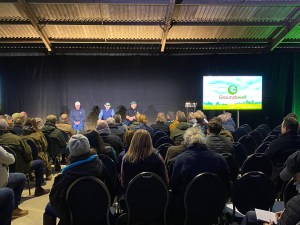
The special Groundswell seminar was a sell out as growers flocked to hear from the man whose book has been an inspiration to many of them.
He and his colleagues are visiting the UK for the first time, thanks to a collaboration with Regenerate Outcomes, 3LM (UK Savory Hub) and their consulting business, Understanding Ag.
“Regenerative agriculture is a thinking person’s game,” begins Gabe. “You have to be able to think, and you have to be able to observe. This is one of the missing links in agriculture today. Farmers have lost the power to observe how nature functions.
“In nature there are six principles that are constant. Put us on any continent, you will find these six principles: context, least amount of mechanical and chemical disturbance, armour on the soil, diversity, living roots in the soil, and livestock/animal integration.
“These are just constant everywhere – you must have them to have a healthy functioning ecosystem.
“It’s these six principles, along with the three rules of adaptive stewardship, that drive the four ecosystem processes: the energy, water and nutrient cycles, and community dynamics, or as we call it, biodiversity.”
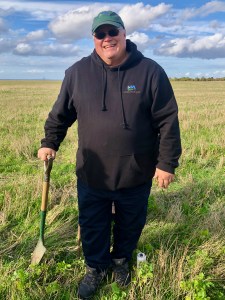
Every single decision you make on the farm either has positive compounding effects or negative cascading effects. You need to take those into consideration before changing any practices, suggests Gabe.
Gabe admits all of this isn’t rocket science. It’s time-tested ecological principles that drive healthy, functioning ecosystems, he says.
That’s what makes it possible, in his eyes, for three American farmers to provide relevant advice to farmers in very different environments across the world.
“We’re not here to tell you how to run your operation. We share our experiences on how to regenerate soils, and then it’s up to you to apply those principles, rules and processes.
“It’s your management, or stewardship, that makes the difference. Every single decision you make on the farm either has positive compounding effects or negative cascading effects. You need to take those into consideration before changing any practices,” suggests Gabe.
But the number one reason the team works with farmers is to help them make money, he stresses. “We’re not farming for the sake of it. You have to be profitable. Yes, we want to do what’s right for the environment but we have to be able to make a living. We shouldn’t be embarrassed about making a reasonable profit.”
Talking through their 6-3-4 framework, Shane New begins with the four ecosystem processes, explaining how a plant captures sunlight, water, carbon dioxide and nitrogen, and produces root exudates which feed bacteria and fungi in the soil.
It’s that soil biology that helps build soil structure, starting with the bacteria creating microaggregates which the fungi tie together into macroaggregates, he says. “Once we develop that, we develop a means to enable mobility for not only the bacteria and fungi, but also their predators, protozoa and nematodes, which are important for nutrient cycling.”
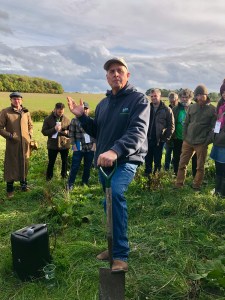
Shane New highlights that the plant and soil are one – aggregation can’t be built without plants; plant can’t grow without soil; microbiology can’t live without either of these, together with a functioning ecosystem.
Good soil structure gives the predators access to the most abundant area for soil biology – the rhizosheath around the roots. “They’re consuming bacteria and fungi, and the immobilised nutrients tied up in them, and mineralising the excess close to the plant, which can then be captured by its roots. That’s the nutrient cycle.
“Our friend Ray Archuleta said it best: ‘the plant and soil are one’. We can’t build aggregation without plants; we can’t have a plant without soil; and we can’t have microbiology without either one of these, together with a functioning ecosystem.”
Gabe returns to run through the reasonably well-known six principles of soil health, highlighting that ecological, financial, social and environmental contexts must be taken into account when developing a holistic approach.
When talking about minimal disturbance he tells a story of how his father-in-law loved recreational tillage. “When he retired, he sold all the farm kit except a tractor. He bought a brand-new disc cultivator and spent his retirement discing for neighbours for free.
When he passed away, he bequeathed Gabe not the tractor but the discs in his will. “I’d been no-tilling for over a decade by that point,” he laughs.
But the serious point is that tillage destroys the biological and ecological integrity of soil, collapsing the pore spaces that allow soil biology to move around, and killing the mycorrhizal fungi that are needed to develop soil aggregates, he explains. Gabe also says that fertilisers kill mycorrhizal fungi.
“Soil aggregates only last about four weeks,” he points out. “I don’t think most growers understand the power of mycorrhizal fungi in building soil aggregates and transferring nutrients.
“No-till systems are the beginning of soil health. But when we consult with clients, are we going to move them immediately to no-till if they’re doing tillage? No, it has to fit their context, but eventually we will move them down the no-till path, over time.”
Over-application of synthetic pesticides and even manures can also be damaging to the soil, he adds. “Manures stored in pits and lagoons can contain a high level of antibiotics, and you can do more harm to the soil by applying it. It’s a real challenge. They need to be applied to living cover crops that can take in and mediate some of those compounds.”
He moves onto the importance of armouring the soil, highlighting that there can be around 7-15⁰C difference in soil temperature between a field with bare soil and one with cover.
“At 21⁰C soil temperature, 100% of moisture can be used for plant growth. As soil temperatures increase, the plant starts shutting down. At 37⁰C, 85% of the soil moisture is lost through evaporation and transpiration and at higher temperatures soil biology is killed. How many farmers are taking soil temperatures into consideration?”
The UK enjoys some environmental advantages, he notes, with usually adequate amounts of moisture and a long growing season. But there are still gaps that could be filled by growing cover crops. “Aim for 12 months of living roots,” he suggests.
Early on when growing cover crops, there’s likely to be too much residue with too much carbon and not enough nitrogen, adds Gabe. “As your systems become biologically active, it will go the other way. But how do you feed that much biology?”
Cover crops are also the way of introducing diversity into rotations. Monoculture cash crops following monoculture cash crops will continue to degrade soils, he says. “Diversity means warm and cool season broadleaved and grasses within your context. The way to get that in arable systems is growing cover crops.
“It’s the cover crops that cycle solar energy and help drive the system for the years of cash crops.”
When designing cover crops, each species should be used to address a specific resource concern, he says. “Your top resource concern should be feeding biology and cycling carbon. But then consider what was the last crop, whether any herbicide used will carry over, and which of the six principles is lacking.
“If it’s soil armour, you need to grow cover crops higher in carbon. If it’s cycling more nitrogen the grow more legumes,” he explains.
Usually he would aim for at least six or seven different species as the more diversity, the more benefit to the soils and ultimately better production.
Out in the field, Gabe uses one of John Cherry’s fields as a backdrop to expand on the principles outlined in the morning. The field had come out of oats and is now sown with a multi-species cover crop before a planned winter bean crop. It’s been no-tilled with very little synthetic fertiliser applied.
He highlights that over-applying any synthetic or organic nutrient can be problematic, that it’s difficult to go ‘cold turkey’ on reducing fertility inputs, and that there’s plentiful availability of nutrients from the atmosphere and in the soil. The key to unlocking that supply is soil biology, he says, stimulated by growing diverse crops and plants.
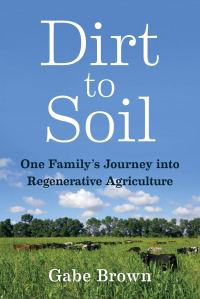
Gabe Brown’s book Dirt to Soil has been inspirational to many growers as they contemplate changing their farming system.
He’s pretty impressed by the Cherry’s progress. “Anybody that has a green living cover cycling solar energy and has cut back significantly on their inputs to drive soil health is a lot further on than most.
“Where I would give them grief, is having a field this size and to not have livestock on it. I don’t care what it took, I’d get livestock grazing. As this grows there is a lot of forage.”
Livestock would help cycle nutrients, he explains. “An average-sized cow cycles 0.23lbs (0.1kg) of nitrogen, 0.15lbs (0.07kg) of phosphorus and 0.5lbs (0.23kg) potassium per day. Start putting 100 head of beef cattle or 500 sheep on here, think of the amount of nutrients you’re cycling.
“And with proper dung beetle populations, that’s going to cycle through very quickly. People wonder how we can grow the yields we do without any synthetics, it’s a combination of the biology in the soil, the earthworms and the livestock.”
He suggests that while you can significantly advance soils without livestock integration, you will never reach full potential without it. “Obviously there will be arable farmers who don’t want to work with livestock, but isn’t there a young person in your community who would love the chance? Why not work with them – it’s to your benefit.”
Q & A with Gabe Brown
The questions from attendees flowed during the 45-minute group discussions in the field. Here are four of the best to Gabe Brown.
How do you deal with slugs?
Slugs tend to proliferate if you have too much thatch building up on the soil surface – too much soil armour, Gabe says. “That’s a carbon:nitrogen ratio problem. You need to change your crop rotation to increase lower carbon plants and decrease higher carbon plants to cycle through the residue quicker. That will help alleviate some of the slug issues.”
He also notes that the larvae of glow worms are a key predator of slugs, but numbers in the UK have declined. “You have to provide the home and habitat for them both in field and on the edge.”
How quickly can you wean soils off applied nitrogen?
Gabe says they use Haney and PLFA (phospholipid fatty acid analysis) soil tests to help determine the level of nutrient cycling. The PLFA helps determine the total viable microbial biomass and gives a general profile – important for determining whether the bacterial/fungal predators that help cycle nutrients are present.
The Haney test helps determine the quantity of soil nutrients available to soil microbes. Previously this test was not available in the UK, though Understanding Ag is working with a couple of laboratories to change that.
“We also do a total nutrient digestion test to prove there is plenty of nutrients available. According to what these tests show, we’re able to give guidance on how quickly you can back off. We normally see that in the first year you can cut by 25%, the next year another 25%, the third year another. We can back off fairly rapidly, but it depends on where your system is at.
“You can’t take a heavily tilled system and do it that quickly – it will be a wreck.”
What’s the one thing you must get right in this system?
“Having soil armour. You have to keep the soil covered,” says Gabe.
That helps retain moisture which is vital for soil biology and protects the biology from extreme temperatures, he explains. “The weak point in my system is moisture. I can control having that armour to keep what little moisture I have in the soil.
“But we’re finding that soil armour is critical everywhere. In higher rainfall areas you still need to keep the soil covered to protect the home for the biology.”
What are you most concerned about in UK systems?
The amount of brassicas in the rotation is a concern, says Gabe. “You have to watch out for oilseed rape as it non-mycorrhizal. I’m not saying not to grow it, but without mycorrhizal fungi you won’t build soil aggregates and therefore soil health.”
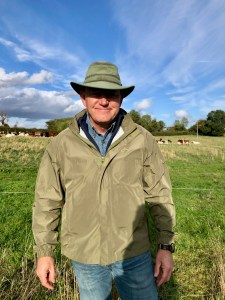
One of the Understanding Ag team, Dr Allen Williams pioneered many of the early regenerative grazing protocols and forage finishing techniques and now teaches those practices and principles to farmers globally.
Flexibility in managing livestock crucial
Just as with diversity of approach helps with weed control, and diversity in cropping and living roots helps improve soil health, flexibility in managing livestock is crucial, says Dr Allen Williams.
“Adaptive grazing – being flexible to changing conditions – brings the greatest results in the shortest period of time,” he explains.
“We’re aiming to re-establish a fully functioning carbon cycle. To do that, we use livestock to stimulate and emulate nature.”
Using different stock densities is a key requirement. “We use all stock densities some of the time, but we use no one stock density all of the time,” he stresses.
“The reason farmers will fail with mob grazing is if you use the same stock density over and over. You’re no longer adaptive and regenerative, you are now prescriptive.”
Other tips for creating disruption in livestock management included altering grazing heights, the length of rest periods for fields, change the pattern of grazing within the rotation and altering the paddock shape, and using different combinations of such tactics.
This article was taken from the latest issue of CPM. For more articles like this, subscribe here.

